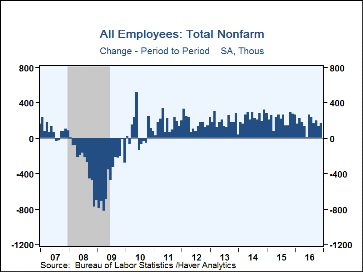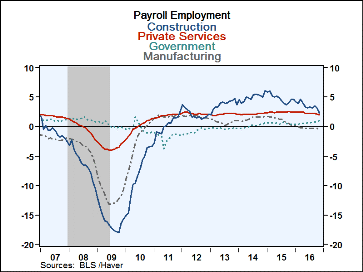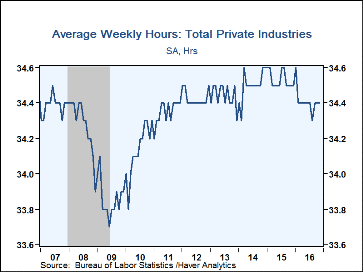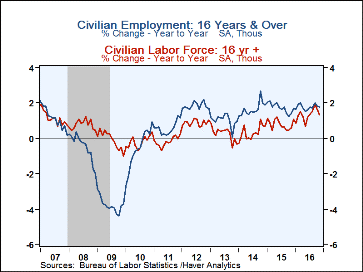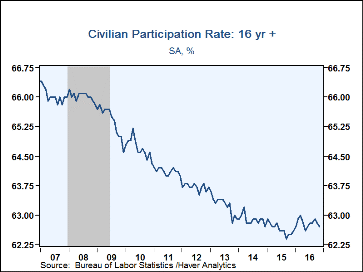 Global| Dec 02 2016
Global| Dec 02 2016U.S. Payroll Increase Improves; Jobless Rate Declines and Earnings Slip
by:Tom Moeller
|in:Economy in Brief
Summary
Nonfarm payroll employment increased 178,000 (1.6% y/y) during November following revised gains of 142,000 and 208,000 in October and September. These had been reported as 161,000 and 191,000, respectively. A 177,000 rise in [...]
Nonfarm payroll employment increased 178,000 (1.6% y/y) during November following revised gains of 142,000 and 208,000 in October and September. These had been reported as 161,000 and 191,000, respectively. A 177,000 rise in employment had been expected in the Action Economics Forecast Survey. Improved job creation was logged by most major employment categories. >From the household survey, the unemployment rate declined to 4.6% versus expected stability at 4.9%. The overall unemployment rate, including marginally attached and those working part-time for economic reasons, fell to 9.3%, its lowest level since April 2008. Average hourly earnings eased 0.1% (+2.5% y/y). A 0.2% rise had been expected.
From the payroll employment survey, the 178,000 increase in jobs left the average monthly change so far this year at 180,000, down from 229,000 in 2015 and 251,000 in 2014. Factory sector employment eased 4,000 last month (-0.4% y/y), about as it has all year. Construction sector employment increased 19,000 in November, up from this year's 10,000 monthly average. That's down, however, from 25,000 per month in 2015 and 30,000 in 2014. Mining sector employment increased 2,100 (-12.1% y/y). It's been down an average 7,000 per month this year after an 11,200 monthly average in 2015.
Private service sector employment increased 139,000, down from this year's 164,000 monthly average and from 205,000 in 2015. Professional & business services jobs rose 63,000 (2.9% y/y), up from this year's 46,000 average. Jobs in education & health services grew 44,000 (2.6% y/y), about as they have this year, but easier than 58,000 in 2015. Employment in leisure & hospitality gained 29,000 (1.9% y/y), about the same as during all of this year, but below 37,000 averaged in both 2015 and 2014. Financial sector employment increased 6,000 (1.9% y/y) and by a stable monthly average 13,000 so far this year. Jobs in trade, transportation & utilities gained 3,000 (1.2% y/y), down from 28,000 averaged per month this year, 38,000 last year and 43,000 in 2011. Employment in the information sector declined 10,000 (+0.5% y/y) after an average no change this year and a 3,000 monthly average gain last year.
Government sector jobs grew 22,000, up from this year's 19,000 average and from last year's 8,000. Employment in the local government rose 14,000, the same as for all of this year. Growth during the past twelve months picked up to 1.1% after declining in each year from 2009 to 2013. State government jobs improved 5,000 (0.1% y/y), and they averaged monthly growth of 1,000 this year after roughly 2,000 in the 2015 and 2014. Employment in federal government improved 3,000 last month (1.9% y/y), about as it has since 2014.
The length of the average workweek remained at 34.4 hours, about where it's been since February. The factory sector workweek eased to 40.6 hours from 40.8 hours. It's averaged 40.7 hours since Q2. The construction sector workweek held at 39.2 hours, nearly the most all year. Average hours worked in the private service sector were steady at 33.3, where they've been all year. Financial activity hours at 37.4 were lessened versus a 37.7 hour peak in Q3'15. Professional & business sector hours of 36.0 where down from a high of 36.4 early in 2014. Leisure & hospitality hours of 26.2 compared to 26.3 averaged last year.
 Average hourly earnings in the private sector eased 0.1% (+2.5% y/y), the first
decline since December. Factory sector earnings fell 0.6% (+2.6% y/y)
and construction sector earnings were off 0.4% (+2.4% y/y). Earnings
in the private service sector were unchanged (2.5% y/y) as a 0.3% rise (2.7%
y/y) in financial sector earnings offset a 0.2% decline in education &
health services (+1.5% y/y). Professional & business services earnings
remained steady (2.4% y/y).
Average hourly earnings in the private sector eased 0.1% (+2.5% y/y), the first
decline since December. Factory sector earnings fell 0.6% (+2.6% y/y)
and construction sector earnings were off 0.4% (+2.4% y/y). Earnings
in the private service sector were unchanged (2.5% y/y) as a 0.3% rise (2.7%
y/y) in financial sector earnings offset a 0.2% decline in education &
health services (+1.5% y/y). Professional & business services earnings
remained steady (2.4% y/y).
From the household employment survey, the decline in the unemployment rate to 4.6%, its lowest level since August 2007, reflected a 160,000 increase (1.8 y/y) in employment and a 226,000 decline (+1.3 y/y) in the labor force. The labor force participation rate fell to 62.7%, its lowest level since June, as the population rose 1.1% y/y. The number of persons not in the labor force rose 0.7% y/y, following stronger declines back through 2010. The average duration of unemployment declined to 26.3 weeks, while the median duration fell to 10.1 weeks.
The teenage unemployment rate eased to 15.2% in November from 16.9% last year, while the rate for those 20-24 years fell to 8.1% this month from 9.7% last year. The unemployment rate for those over age 25 eased to 3.9% from 4.3% in 2015. Within that group, the lowest rate was for workers aged 45 to 54 years at 3.5%.
By educational attainment, unemployment amongst persons without a high school diploma rose to 7.9%. For high school graduates but no college, unemployment was 4.9%, while for those with some college or an associate degree, it was 3.9%. College graduates experienced 2.3% unemployment.
The labor market data are contained in Haver's USECON database. Detailed figures are in the EMPL and LABOR databases. The expectations figure is in the AS1REPNA database.
Just How Important Are New Businesses? from the Federal Reserve Bank of Philadelphia can be found here.
| Employment: (SA, M/M Change, 000s) | Nov | Oct | Sep | Nov Y/Y | 2015 | 2014 | 2013 |
|---|---|---|---|---|---|---|---|
| Payroll Employment | 178 | 142 | 208 | 1.6 | 2.1% | 1.9% | 1.6% |
| Previous | -- | 161 | 191 | -- | -- | -- | -- |
| Manufacturing | -4 | -5 | -6 | -0.4 | 1.1 | 1.4 | 0.8 |
| Construction | 19 | 14 | 26 | 2.4 | 4.8 | 5.0 | 3.7 |
| Private Service-Producing | 139 | 128 | 184 | 2.0 | 2.5 | 2.1 | 2.1 |
| Government | 22 | 7 | 3 | 1.0 | 0.5 | 0.0 | -0.3 |
| Average Weekly Hours - Private Sector | 34.4 | 34.4 | 34.4 | 34.5 | 34.5 | 34.5 | 34.5 |
| Private Sector Average Hourly Earnings (%) | -0.1 | 0.4 | 0.3 | 2.5 | 2.3 | 2.1 | 2.1 |
| Unemployment Rate (%) | 4.6 | 4.9 | 5.0 | 5.0 | 5.3 | 6.2 | 7.4 |
Tom Moeller
AuthorMore in Author Profile »Prior to joining Haver Analytics in 2000, Mr. Moeller worked as the Economist at Chancellor Capital Management from 1985 to 1999. There, he developed comprehensive economic forecasts and interpreted economic data for equity and fixed income portfolio managers. Also at Chancellor, Mr. Moeller worked as an equity analyst and was responsible for researching and rating companies in the economically sensitive automobile and housing industries for investment in Chancellor’s equity portfolio. Prior to joining Chancellor, Mr. Moeller was an Economist at Citibank from 1979 to 1984. He also analyzed pricing behavior in the metals industry for the Council on Wage and Price Stability in Washington, D.C. In 1999, Mr. Moeller received the award for most accurate forecast from the Forecasters' Club of New York. From 1990 to 1992 he was President of the New York Association for Business Economists. Mr. Moeller earned an M.B.A. in Finance from Fordham University, where he graduated in 1987. He holds a Bachelor of Arts in Economics from George Washington University.


